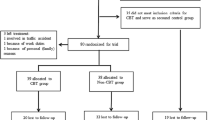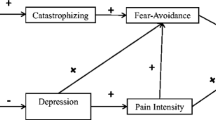Abstract
The success of multidisciplinary treatments for chronic pain in helping patients suffer less and function better is well documented. However, this success has occurred despite a lack of understanding of the process of change that produces positive outcomes. The purpose of this study was to investigate the role of pain-related anxiety reduction in the outcome of treatment for chronic pain. Seventy-nine persons with chronic pain completed measures of pain, pain-related interference with activity, affective distress, general daily activity, and pain-related anxiety at admission and immediately following a 3-week multidisciplinary treatment program focusing on functional restoration. Patients significantly improved on all outcome measures. Reductions in pain-related anxiety predicted improved functioning on each measure. Additional analyses showed that change in pain-related anxiety remained a significant predictor of outcome independent of change in depression.
Similar content being viewed by others
REFERENCES
Hazard RG, Fenwick JW, Kalisch SM, Redmond J, Reeves V, Reid S, Frymoyer JW. Functional restoration with behavioral support: A one-year prospective study of patients with chronic low-back pain. Spine 1988; 14: 157–161.
Nicholas MK, Wilson PH, Goyen J. Operant-behavioral and cognitive-behavioral treatment for chronic low back pain. Behav Res Ther 1991; 29: 225–238.
Flor H, Fydrich T, Turk DC. Efficacy of multidisciplinary pain treatment centers: A meta-analytic review. Pain 1992; 49: 221–230.
Spinhoven P, Linssen ACG. Behavioral treatment of chronic low back pain: I. Relation of coping strategy use to outcome. Pain 1991; 45: 29–34.
Tota-Faucette ME, Gil KM, Williams DA, Keefe FJ, Goli V. Predictors of response to pain management treatment: The role of family environment and changes in cognitive processes. Clin J Pain 1993; 9: 115–123.
Jensen MP, Turner JA, Romano JM. Correlates of improvement in multidisciplinary treatment for chronic pain. J Consult Clin Psychol 1994; 62: 172–179.
McCracken LM, Zayfert C, Gross RT. The Pain Anxiety Symptoms Scale: Development and validation of a scale to measure fear of pain. Pain 1992: 50: 67–73.
McCracken LM, Gross RT, Sorg PJ, Edmands TA. Prediction of pain in patients with chronic low back pain: Effects of inaccurate prediction and pain-related anxiety. Behav Res Ther 1993; 31: 647–652.
Vlaeyen JWS, Kole-Snijders AMJ, Boeren RGB, van Eek H. Fear of movement/(re) injury in chronic low back pain and its relation to behavioral performance. Pain 1995; 62: 363–372.
McCracken LM, Gross RT. Does anxiety affect coping with chronic pain? Clin J Pain 1993; 9: 253–259.
Waddell G, Newton M, Henderson I, Somerville D, Main C. A fear-avoidance beliefs questionnaire (FABQ) and the role of fear-avoidance beliefs in chronic low back pain and disability. Pain 1993; 52: 157–168.
McCracken LM, Gross RT, Aikens J, Carnrike CLM. The assessment of anxiety and fear in persons with chronic pain: A comparison of instruments. Behav Res Ther 1996; 34: 927–933.
McCracken LM, Gross RT. The Pain Anxiety Symptoms Scale (PASS) and the assessment of emotional responses to pain. In: VandeCreek L, Knapp S, Jackson TL, eds. Innovations in clinical practice: A sourcebook, Vol. 14. Sarasota, Florida: Professional Resources Press, 1995, pp. 309–321.
Beck AT, Ward CH, Mendelson M, Mock J, Erbaugh J. An inventory for measuring depression. Arch Gen Psychiat 1961; 4: 561–571.
Beck AT, Steer RA, Garbin MG. Psychometric properties of the Beck Depression Inventory: Twenty-five years of evaluation. Clin Psychol Rev 1988; 8: 77–100.
Kerns RD, Turk DC, Rudy TE. The West Haven-Yale Multidimensional Pain Inventory (WHYMPI). Pain 1985; 23: 345–356.
Banks SM, Kerns RD. Explaining high rates of depression in chronic pain: A diathesis-stress framework. Psychol Bull 1996; 119: 95–100.
Mayer TG, Gatchel RJ, Kishino ND, Keeley J, Capra P, Mayer H, Barnett J, Mooney V. Objective assessment of spine function following industrial injury: A prospective study with comparison group and one-year follow-up. Spine 1985; 10: 482–492.
Gatchel RJ, Mayer TG, Hazard RG, Rainville J, Mooney V. Editorial: Functional restoration: Pitfalls in evaluating efficacy. Spine 1992; 17: 988–995.
Author information
Authors and Affiliations
Corresponding author
Rights and permissions
About this article
Cite this article
McCracken, L.M., Gross, R.T. The Role of Pain-Related Anxiety Reduction in the Outcome of Multidisciplinary Treatment for Chronic Low Back Pain: Preliminary Results. J Occup Rehabil 8, 179–189 (1998). https://doi.org/10.1023/A:1021374322673
Issue Date:
DOI: https://doi.org/10.1023/A:1021374322673




